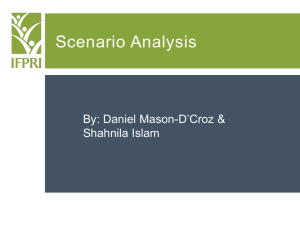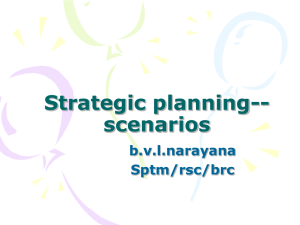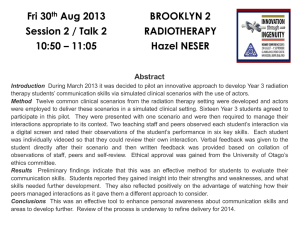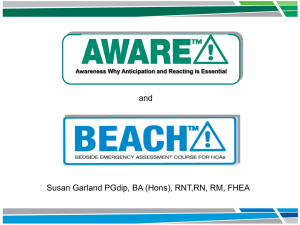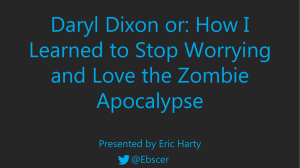L08- Stress Testing Banks and Financial Institutions
advertisement
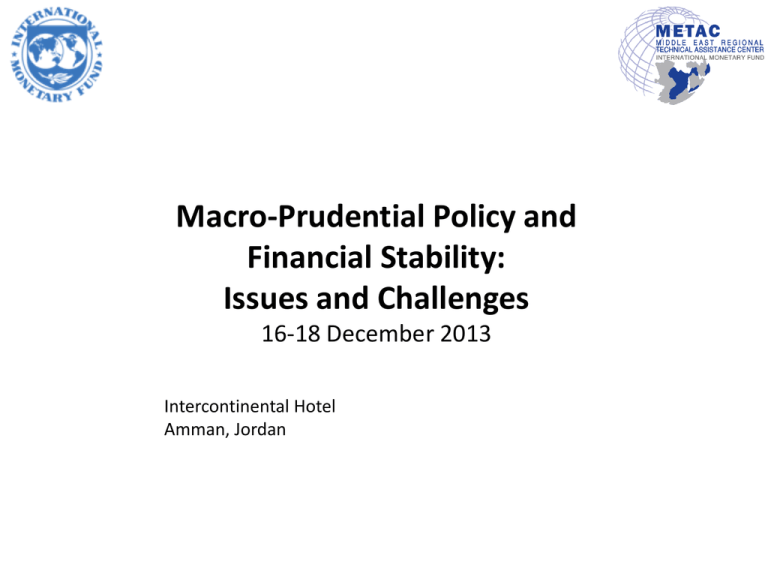
Macro-Prudential Policy and Financial Stability: Issues and Challenges 16-18 December 2013 Intercontinental Hotel Amman, Jordan Stress Testing Banks and Financial Institutions • • • Good practices Stress testing models and scenarios Practical considerations Mr. Keith Pooley METAC Banking Supervision Technical Expert GOOD PRACTICES WHAT DOES BASEL SAY ABOUT STRESS TESTING? The importance of stress testing Stress Testing and Risk Governance “Stress testing plays an important role in: “Stress testing should form an integral part of the overall governance and risk management culture of the bank. providing forward-looking assessments of risk; overcoming limitations of models and historical data; supporting internal and external communication; feeding into capital and liquidity planning procedures; informing the setting of a banks’ risk tolerance; and facilitating the development of risk mitigation or contingency plans across a range of stressed conditions.” Stress testing should be actionable, with the results from stress testing analyses impacting decision making at the appropriate management level, including strategic business decisions of the board and senior management. Board and senior management involvement in the stress testing programme is essential for its effective operation.” Stress Testing and Capital Plans “Supervisors should consider the results of sensitivity analyses and stress tests conducted by the institution and how these results relate to capital plans.” 3 STRESS TESTING GOOD PRACTICES The following slide provides an example of good practice in relation to the Governance Framework The process is Board-led, with the Board: proposing some of the scenarios to be run challenging approaches, scenarios and outputs approving approaches, scenarios and outputs receiving sufficient training to support these objectives GOOD PRACTICES - GOVERNANCE Under leading practice, stress testing needs a set of governance arrangements driven primarily by the Board and an integrated operating framework. GOVERNANCE FRAMEWORK Board and senior management engagement Regular review of programme to assess its effectiveness Governance of stress testing and use Outputs are actionable and inform strategic decision making Clear responsibilities, allocated resources, and written policies and procedures Embedded into risk management processes and supported with an appropriate risk infrastructure GOOD PRACTICES – OPERATING FRAMEWORK The following slide provides an example of good practice in relation to the accompanying Operating Framework The framework encompasses: macroeconomic stress tests, scenario / ‘what-if’ analysis and sensitivity analysis - appropriate for the scale and complexity of the asset classes assumptions are sufficiently challenged and tested Outputs inform: management actions and gross and net impacts Pre-emptive responses to manage vulnerabilities Strategy and capital/liquidity requirements GOOD PRACTICES – OPERATING FRAMEWORK OPERATING FRAMEWORK Firm strategy Capital planning •Identifying capital required to support growth •Link to ICAAP Stress Testing Quantitative Elements (e.g. GDP, CPI) Define scenarios Identify consequence Assess impact (quantitative & qualitative) 7 TYPES OF STRESS TESTS TYPES OF STRESS TESTS Sensitivity analysis Defined by shift in sensitivity variable Relatively easy to define and implement – often used at trading desk and business line level Exposure Shifts in several variables have to be used in order to simulate historical events Correct use of stressed correlations between risk types is essential Rating class SENSITIVITY AND SCENARIO ANALYSIS APPLIED TO CREDIT RISK AND MARKET RISK Sensitivity analysis Credit risk Market risk (incl ALM) What if all ratings worsen by one grade? What if default rates double in portfolios X,Y,Z? What if all correlations on our credit portfolio model increase by 20%? What is our collateral recovery rates are systematically 25% lower for real estate collateral? What is the EUR/USD rate changes by X%? Scenario analysis What if there was an emerging market crisis (contagion effects)? GDP down 6-8%? Deflationary vs. inflationary? What if the previous historical boom and bubble in house prices leads to a long-lasting retail mortgage credit crisis? Parallel shift of yield curve by X basis points? What if exchanges rates or interest rates behave as they did historically during period X? Increased in implied volatility of European stocks of Y% What if interbank liquidity dries up during next economic shock? 10 THE CLASSIFICATION OF GLOBAL STRESS SCENARIOS Global stress scenarios can be classified accordiing to the construction of the scenarios Moderate scenarios Challenging scenarios Extreme scenarios TOP DOWN APPROACH TO DEFINING STRESS SCENARIO Competitive expectation Senior management Macro-economic expectation Strategic planning department Business & risk strategy Research department incl. chief economist Translation of strategy into targets as well as business, risk and capital planning requires planning assumptions • What makes the business case profitable? • What could endanger our business case? • Where are the considerable concentrations (products, customers, markets) ? • What are the biggest threats of our strategy? • “What if” strategic decisions fail (e.g. acquisition, capital increase) 12 Definition of planning assumptions Best case planning scenario Normal case planning scenario Stress case planning scenario 1 Stress case planning scenario 2 Stress case planning scenario 3 • On which economic drivers does the business case depend? • What are macro-economic expectations? • What about business cycle effects? • What are unlikely by possible economic crisis? • How would counterparties, customers and competitors be effected by a crisis? Risk controlling Moderation of scenario definition and portfolio input HIERARCHY OF STRESS TESTS Global scenarios Scenario analysis Sensitivity analysis LINKING MACROECONOMIC EVENTS WITH THE TARGET METRIC Process for thinking through linkage between macroeconomic events and target metric in scenario based layered stress-testing Portfolio characteristics Macroeconomic scenarios Macroeconomic factors Historical: GDP Score distribution PD Earthquake Interest rates Segment distribution LGD Recessions Exchange rate … EAD Credit crises Debt ratio Utilization Hypothetical: Asset prices Attrition Extended recession Consumer sentiment Response … Process costs Correlation of events ... Risk drivers Delinquency … Target metric Portfolio loss (Accounting) Portfolio loss (Economic loss) Provisioning/Writeoffs Cap. Requirements Reduced margins Breakdown of new business Fall in share price … 14 REVERSE STRESS TESTING – TEST TO DESTRUCTION Reverse stress testing Reverse stress testing should be modelled through various stresses and consider factors relating specifically to the firm as well as the external environment. Considerations when devising tests: Proportionality Basis of scenarios: hypothetical v historical Internal v external shocks Idiosyncratic v market wide stress Rapid crystallisation versus protracted impact Solo v Group Scenarios that could lead to business failure Why do it? ■ Explore business model vulnerabilities ■ Engage senior management ■ Confront possibility of failure ■ Make decisions that better integrate risk management Mitigating actions or triggers for future action ■ Improve contingency planning ■ Inform stress testing framework It should be used as a risk management tool – not a means of directly increasing capital requirements 15 EMBEDDING THE STRESS TESTING PROCESS Scenario Generation Credit Risk Department Suggests credit risk relevant scenarios covering bank wide, regional, portfolio or product specific credit risks Market Risk Department Suggests scenarios in ALM, market and liquidity risk Operational Risk Department Prioritisation First Pass Quantification Workshop o better understand scenarios and underlying risks Risk acts as moderator and supplies basic portfolio parameters in order to allow quantification Discussion based quantification to extract insights before more rigorous first pass quantification by central team Suggests scenarios on external, fraud, litigation, IT or compliance risks Management / Business Suggest strategic, bank-wide and business case specific scenarios 16 Review of first pass quantification Central project team All scenarios are assigned a rough probability and impact Quantification Review of selection Reviews selection of pilot scenarios with representatives from (Sen.) Management, Business, Risk Prioritisation – Pilot Scenarios Select based on probability and impact Pilot scenarios based also on variety Additional second tier risks to be covered later or at less accuracy Senior Management bears ultimate responsibility Review of Quantification Risk functions review results and provide comments, in particular for their own risks Group risk is ultimately responsible for scenario analysis Results reported to Management and Business Final Scenario Quantification For each scenario estimates for probability and impact are justified by using various sources Macro model (recessions, avian flu, real estate), benchmarks (most), theoretical model / distribution analytics (ALM, market, credit concentrations), external data (mis-selling), think tank (ship sunk) STRESS TESTING DESIGN INVOLVES A LOT OF REFLECTIONS • Under which scenarios is my business model seriously endangered? Design and strategy • What will cause my business model to fail? • What happens to my business in the next crisis? • Which risk drivers are relevant to my business? • In which scenarios would my largest sensitivities lead to major losses? • Whom in my organisation should I involve in the design, modelling, parameterisation and evaluation of stress scenarios Methodology • How do I translate (top-down) scenarios to relevant risk drivers, and what severity do apply? • What level of sophistication in describing and modelling of scenarios do I need to apply to capture their essence? • Which parameters should be shocked (how)? Over what time horizon? Implementation and evaluation • How are second order effects and feedback incorporated? • What do I do with the results of stress testing? • To what degree may I anticipate help from the outside (investors, central bank, government)? 17 KEY SUCCESS FACTORS WHEN SETTING-UP A STRESS TESTING FRAMEWORK Clearly define the perimeter, i.e. the group on a consolidated level Adequately involve business and senior management at all levels of stress testing 18 Clearly identify the target metric, e.g. the P&L, capital, external rating,… Validate stress testing results, question and refine scenarios across time Create a real risk culture across the organization – get stress testing out of the risk function Identify the variables that have the most effect on target variables Link stress testing results to action, e.g. outright acceptance, evaluate contingency planning THE IMPORTANCE OF STRESS TESTING LIQUIDITY “Many banks despite adequate capital levels experienced difficulties because they not manage their liquidity in a prudent manner……The rapid reversal in market conditions illustrated how quickly liquidity can evaporate and that illiquidity can last for an extended period of time…..” Basel 3 30 July 2007 17 August 2007 15 September 2008 13 October 2008 National bail-outs: Germany - €470bn, France - €340bn, USA - $250bn bank nationalization, Spain - €100bn 17 August 2007 15 September 2008 17 February 2008 14 March 2008 16 September 2008 15-31 October 2008 Tapped national bail-out funds RBOS, HBOS, Lloyds, Commerzbank, Bank of America, JPMorgan Chase, Citigroup, Wells Fargo, Goldman Sachs, Morgan Stanley and more LIQUIDITY RISK STRESS TESTING Basel 3 prescribes stress testing should consider the two types of stress tests below and combinations of both Institution specific Market wide (idiosyncratic) (systemic) Name-specific rumours and bad news. Wholesale funding Downgrade and negative outlook. Retail funding Retail run? Marketable assets 10 risk drivers Funding concentration Wholesale run? Short term market disruption Long term erosion in funding sources due to Off-balance sheet ongoing market tightening Franchise viability I Non-marketable assets Intra-day liquidity Intra-group liquidity Cross currency Combined stress test Name specific concerns - restricting recovery LIQUIDITY RISK STRESS TESTING Idiosyncratic Impact First two weeks Out to 3 months Inability to roll over wholesale secured and unsecured funding Sustained leakage of funds Sizeable retail outflow Sustained outflow Reduced intra-day credit provided by firm’s settlement bank Increase in payments withheld to a clearer Prefunding for all payments Closure of FX markets Intra-group deposits repaid at maturity, intra- group loans treated as evergreen Multiple downgrade of long-term rating Gradual return to normality Systemic Impact Uncertainty of accuracy of valuation of assets and those of counterparties. Inability to realise or realise particular classes of assets only at excessive cost. Risk aversion in funding markets. Uncertainty as to the ability of a significant number of banks to meet liabilities EXAMPLE OF A CAPITAL STRESS TESTING Economic variable Year US GDP 2013 2.4% -1.8% -2.1% Unemployment 2014 7.2% 13.4% 13.5% House Price Index 2015 4.5% -13.1% -14.7% GDP 2013 2.2% -1.6% -3.9% Unemployment 2014 7.1% 13.1% 15.2% House 600.0 price indices 2015 -2% -18.2% 19.1% Euro Base Case Regulatory mandatory test Eurozone Sovereign 18% Pillar 1 RWAs (Stress) 16% 500.0 Pillar 1 RWAs (Base) £ mns RWA £bn 14% 400.0 12% Minimum Core Tier 1 % = 6% (Base) 10% 300.0 8% 200.0 6% 4% 100.0 2% 0.0 0% Based Stress 2011 2009 Based Stress 2012 2010 Based Stress 2013 2011 Based Stress 2014 2012 Based Stress 2015 2013 Minimum Core Tier 1 % = 4% (Stress) CoreInsuracne Tier 1 as- % of Post Core RWAs (base) Tier 1 as % P1 RWA (Base) CoreInsurance Tier 1 as- % of Post Core RWAs Tier 1 as(Stressed) % P1 RWA (Stress)
